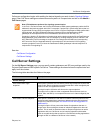
Superclustering
Polycom, Inc. 228
● Create a new supercluster by pointing it to another free-standing (not superclustered) Polycom
RealPresence DMA system. Both systems become clusters in the new supercluster. The system
you’re logged in to has its local data store largely replaced by a copy of the data store from the system
to which you pointed it. The data from that other system becomes the shared supercluster data store.
● Add the system to an existing supercluster by pointing it to one of the existing clusters in the
supercluster. The system you’re logged in to becomes one of the clusters in that supercluster, and its
local data store is largely replaced by a copy of the shared supercluster data store.
If a supercluster exists, the Remove from Supercluster command lets you remove the cluster selected in
the list from the supercluster, re-initializing it as a new stand-alone cluster. It retains the data and
configuration from the supercluster (including site topology), but that data is no longer synchronized to the
common data store. If the cluster you’re removing is responsible for any territories (as primary or backup),
you must first reassign those territories. The cluster being removed may be either the one you’re logged in
to or another cluster. The system prompts you to confirm.
The Busy Out command gracefully winds down the use of the selected cluster:
● Existing calls and conferences on the selected cluster continue, but no new conferences are allowed
to start. New calls are allowed to start only if they are associated with existing conferences.
Registrations are rejected, except for endpoints currently involved in calls. The cluster ceases to
manage bandwidth.
● Territories for which the selected cluster has primary responsibility and a different cluster has backup
responsibility are transferred to the backup cluster.
● Registrations are seamlessly transferred to the backup cluster (for endpoints that support this).
Bandwidth usage data for ongoing calls is seamlessly transferred to the backup cluster.
The Stop Using command takes the selected cluster immediately out of service:
● Existing calls and conferences on the selected cluster are disconnected. No new calls or conferences
are allowed to start. All registrations are rejected. The cluster ceases to manage bandwidth.
Caution: Adding a cluster to a supercluster overwrites data
When you add the cluster you’re logged in to to an existing supercluster, virtually all of that cluster’s
data and configuration are replaced by the shared data and configuration of the supercluster. This
includes, among other things, users, groups, conference rooms, site topology, Conference Manager
configuration, Call Server configuration, and integrations.
When you create a new supercluster, the data and configuration of the cluster you’re logged in to are
replaced by the data and configuration of the cluster to which you’re pointing it.
Be sure you create a new supercluster by joining the cluster you’re logged in to to the cluster that has
the data and configuration you want to preserve. For instance, if one of the clusters is integrated with
your Polycom RealPresence Resource Manager system, join the other cluster to it, not the other way
around.
Note: Superclusters and RealPresence Resource Manager integration
You can’t add a Polycom RealPresence Resource Manager system to a supercluster or create a
supercluster with a Polycom RealPresence Resource Manager system. But you can integrate a
Polycom RealPresence DMA cluster with a Polycom RealPresence Resource Manager system in
order to get site topology and user-to-device association data from the latter (see RealPresence
Resource Manager Integration). You can do this either before or after creating a Polycom
RealPresence DMA supercluster. The site topology and user-to-device association data is replicated
throughout the supercluster.


















